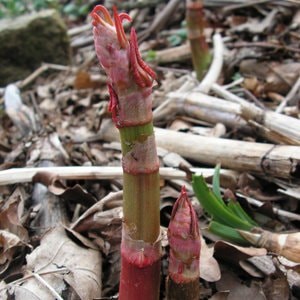Japanese knotweed is an invasive and resilient weed. Its roots and rhizomes can grow to a depth of 2m. Even after herbicide treatment has “eradicated” the aerial and surface growth, the deep underground rhizomes can remain in a viable state and may do so for up to twenty years.
It can re-emerge and re-grow on its own accord at any time and especially if the contaminated ground is disturbed. If knotweed is left to grow untreated for a number of years it has the potential to cause damage to drains, paving, paths, driveways and poorly constructed boundary walls.

For this reason it should not be ignored.
There are two main pieces of legislation that cover Japanese Knotweed:
Wildlife and Countryside Act 1981 – Schedule 9, Section 14 of the Act, it is an offence to plant or otherwise cause the species to grow in the wild.
Section 14(2) of the Wildlife and Countryside Act 1981 states that “if any person plants or otherwise causes to grow in the wild any plant which is included in Part 2 of Schedule 9, he shall be guilty of an offence”. (Japanese knotweed is a Schedule 9 listed plant).
Environmental Protection Act 1990 – Specifically dealing with the disposal of ‘Controlled waste’. Japanese Knotweed falls into this category, and must be received through licensed landfills, if not dealt with in another suitable way.
An offence under the Wildlife and Countryside Act can result in a criminal prosecution.
An infringement under the Environmental Protection Act can result in enforcement action being taken by the Environment Agency which can result in an unlimited fine.
You can also be held liable for costs incurred from the spread of Knotweed into adjacent properties and for the disposal of infested soil off site during development which later leads to the spread of Knotweed onto another site.Japanese Knotweed is the most widespread form of Knotweed. Distinctive identifiers are a growth pattern of one stem per node, which forms a zig-zag stem growth pattern. The leaves are fairly smooth, mid-green in colour, with a characteristic straight back edge, giving the overall leaf a shield, shovel or heart type shape.
The knotweed flowers are small creamy-white and form in loose clusters (panicles) in late summer/early autumn. All Japanese knotweed plants growing in the UK are female and therefore do not produce viable seeds.
The first step in assessing any Japanese Knotweed problem is a Japanese Knotweed Survey. From the survey, you will be armed with the right information to understand the extent of any infestation and the appropriate action to take. C&C Consulting Services Ltd can put you in touch with a specialist in the identification and removal of this plant.
Japanese Knotweed is a non-native invasive weed that was brought to the UK in the 19th century as an ornamental plant. However, it poses an enormous risk to the native bio-diversity in the UK. Not only can it damage and destroy hard surfaces, such as tarmac, concrete and brick walls, the plant grows so quickly and spreads so easily, it can deprive native plants of nutrients and sunlight, causing them to die.
If this nuisance exists both commercially or privately you must comply with the law, there are many solutions to its eradication, contact C&C Consulting for further information.











